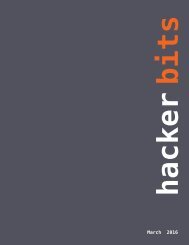Hacker Bits, August 2016
HACKER BITS is the monthly magazine that gives you the hottest technology stories crowdsourced by the readers of Hacker News. We select from the top voted stories and publish them in an easy-to-read magazine format. Get HACKER BITS delivered to your inbox every month! For more, visit https://hackerbits.com/2016-08.
HACKER BITS is the monthly magazine that gives you the hottest technology stories crowdsourced by the readers of Hacker News. We select from the top voted stories and publish them in an easy-to-read magazine format.
Get HACKER BITS delivered to your inbox every month! For more, visit https://hackerbits.com/2016-08.
Create successful ePaper yourself
Turn your PDF publications into a flip-book with our unique Google optimized e-Paper software.
If you’re trying to be generally<br />
effective, my best advice is to<br />
start with the things on this list.<br />
• The numbers next to each<br />
mental model reflect the<br />
frequency with which they<br />
come up:<br />
1. Frequently (63 models)<br />
2. Occasionally (43 models)<br />
3. Rarely, though still repeatedly<br />
(83 models)<br />
• If studying new models, I’d<br />
start with the lower numbers<br />
first. The quotes next<br />
to each concept are meant<br />
to be a basic definition to<br />
remind you what it is, and is<br />
not a teaching tool. Follow<br />
the link to learn more.<br />
• I am not endorsing any of<br />
these concepts as normatively<br />
good; I’m just saying<br />
they have repeatedly helped<br />
me explain and navigate the<br />
world.<br />
• I wish I had learned many of<br />
these years earlier. In fact,<br />
the proximate cause for<br />
posting this was so I could<br />
more effectively answer the<br />
question I frequently get<br />
from people I work with:<br />
“What should I learn next?” If<br />
you’re trying to be generally<br />
effective, my best advice is<br />
to start with the things on<br />
this list.<br />
Explaining<br />
• (1) Hanlon’s razor — “Never<br />
attribute to malice that<br />
which is adequately explained<br />
by carelessness.”<br />
(Related: fundamental attribution<br />
error — “the tendency<br />
for people to place an undue<br />
emphasis on internal characteristics<br />
of the agent (character<br />
or intention), rather than<br />
external factors, in explaining<br />
another person’s behavior<br />
in a given situation.”)<br />
• (1) Occam’s razor — “Among<br />
competing hypotheses, the<br />
one with the fewest assumptions<br />
should be selected.”<br />
(Related: conjunction fallacy,<br />
overfitting, “when you hear<br />
hoof beats, think of horses<br />
not zebras.”)<br />
• (1) Cognitive biases — “Tendencies<br />
to think in certain<br />
ways that can lead to systematic<br />
deviations from a<br />
standard of rationality or<br />
good judgments.” (See list of<br />
cognitive biases)<br />
• (1) Arguing from first principles<br />
— “A first principle is a<br />
basic, foundational, self-evident<br />
proposition or assumption<br />
that cannot be deduced<br />
from any other proposition<br />
or assumption.” (Related:<br />
dimensionality reduction, orthogonality)<br />
• (1) Proximate vs root<br />
cause — “A proximate cause<br />
is an event which is closest<br />
to, or immediately responsible<br />
for causing, some<br />
observed result. This exists<br />
in contrast to a higher-level<br />
ultimate cause (or distal<br />
cause), which is usually<br />
thought of as the ‘real’<br />
reason something occurred.”<br />
(Related: 5 whys — “to determine<br />
the root cause of a<br />
defect or problem by repeating<br />
the question ‘Why?’)<br />
Modeling<br />
• (1) Systems thinking — “By<br />
taking the overall system as<br />
well as its parts into account,<br />
systems thinking is designed<br />
to avoid potentially contributing<br />
to further development<br />
of unintended consequences.”<br />
(Related: causal loop<br />
diagrams, stock and flow, Le<br />
Chatelier’s principle, hysteresis—<br />
“the time-based dependence<br />
of a system’s output<br />
on present and past inputs.”)<br />
• (1) Scenario analysis — “A<br />
process of analyzing possi-<br />
26 hacker bits















